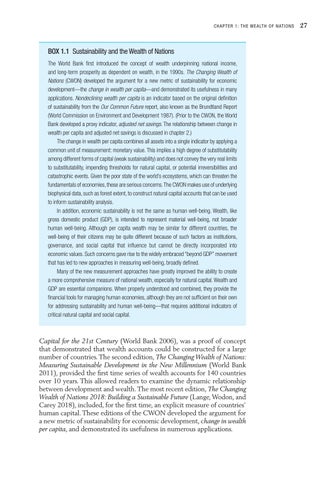C H AP TE R 1: T he Wea lth o f Nation s
BOX 1.1 Sustainability and the Wealth of Nations The World Bank first introduced the concept of wealth underpinning national income, and long-term prosperity as dependent on wealth, in the 1990s. The Changing Wealth of Nations (CWON) developed the argument for a new metric of sustainability for economic development—the change in wealth per capita—and demonstrated its usefulness in many applications. Nondeclining wealth per capita is an indicator based on the original definition of sustainability from the Our Common Future report, also known as the Brundtland Report (World Commission on Environment and Development 1987). (Prior to the CWON, the World Bank developed a proxy indicator, adjusted net savings. The relationship between change in wealth per capita and adjusted net savings is discussed in chapter 2.) The change in wealth per capita combines all assets into a single indicator by applying a common unit of measurement: monetary value. This implies a high degree of substitutability among different forms of capital (weak sustainability) and does not convey the very real limits to substitutability, impending thresholds for natural capital, or potential irreversibilities and catastrophic events. Given the poor state of the world’s ecosystems, which can threaten the fundamentals of economies, these are serious concerns. The CWON makes use of underlying biophysical data, such as forest extent, to construct natural capital accounts that can be used to inform sustainability analysis. In addition, economic sustainability is not the same as human well-being. Wealth, like gross domestic product (GDP), is intended to represent material well-being, not broader human well-being. Although per capita wealth may be similar for different countries, the well-being of their citizens may be quite different because of such factors as institutions, governance, and social capital that influence but cannot be directly incorporated into economic values. Such concerns gave rise to the widely embraced “beyond GDP” movement that has led to new approaches in measuring well-being, broadly defined. Many of the new measurement approaches have greatly improved the ability to create a more comprehensive measure of national wealth, especially for natural capital. Wealth and GDP are essential companions. When properly understood and combined, they provide the financial tools for managing human economies, although they are not sufficient on their own for addressing sustainability and human well-being—that requires additional indicators of critical natural capital and social capital.
Capital for the 21st Century (World Bank 2006), was a proof of concept that demonstrated that wealth accounts could be constructed for a large number of countries. The second edition, The Changing Wealth of Nations: Measuring Sustainable Development in the New Millennium (World Bank 2011), provided the first time series of wealth accounts for 140 countries over 10 years. This allowed readers to examine the dynamic relationship between development and wealth. The most recent edition, The Changing Wealth of Nations 2018: Building a Sustainable Future (Lange, Wodon, and Carey 2018), included, for the first time, an explicit measure of countries’ human capital. These editions of the CWON developed the argument for a new metric of sustainability for economic development, change in wealth per capita, and demonstrated its usefulness in numerous applications.
27


